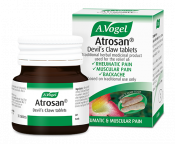What happens to our muscles as we age?
Sarcopenia is the medical term given to muscle loss and is derived from Greek origins, roughly translating as ‘vanishing flesh.’1 Now this can be as terrifying as it sounds as it can wind up being extremely debilitating if left unsupervised; it can interfere with our reflexes and even our energy levels. Although losing muscle as we age is a natural process there are steps we can take to limit how much we can do as well as support our muscles and joints.
Muscle atrophy can also occur; this is where muscles waste away often as a result of lack of physical activity. This can be caused by medical conditions or disease but it can also be another unfortunate effect of ageing. There are a number of factors that can contribute to faster ageing of our muscles, major risk factors include low levels of muscular fitness and insufficient dietary intake.

What causes changes to our muscles as we age?
• Hormones
Decreases in hormones such as testosterone and growth hormone can contribute. Hormonal changes such as menopause can also play a role. Falling oestrogen levels (which occur during menopause) can affect the hydration of the joints, ligaments and tendons, which can lead to a whole number of aches and pains in our muscles and joints.
• Diet
If we have inadequate calorie and protein intake, we will be unable to sustain our muscle mass over time. This in turn will inevitably lead to weaker muscles and overall poorer muscle health. Foods that promote inflammation, such as meat and dairy, can negatively impact our muscles, causing pain and increasing recovery time after exercising or injury.
• Inactivity
Remaining inactive for long periods of time will definitely contribute to loss of muscle mass in older age. Not only that, we’ll also find that we lose mobility too, as inactivity causes our joints to stiffen up and our muscles to lose flexibility.
Keep active
Keeping active has been shown to be beneficial in lowering the risk for developing multiple diseases including: coronary heart disease, obesity, type 2 diabetes, high blood pressure, osteoporosis, osteoarthritis, and high cholesterol levels.2 In terms of sarcopenia, or losing muscle, exercise has a direct impact on muscle quality and quantity. Research has found that physical activity can help to protect our muscles against losing muscle as we age.3
In your 20s exercising through discomfort and pain can become a habit but, as we get older, it’s important to start listening to our body. As we age it can become trickier to bounce back from injuries, particularly if we ignore the signals our body tells us that it’s had enough.

Think about strengthening
Sometimes when we think of strength training, weight-lifting or resistance training, we’re immediately bombarded with an array of terrifying thoughts of humongous weights and pushing your body to extremes. However, this definitely doesn’t need to be the case. Yes strengthening is extremely important when it comes to preventing muscle loss, but there are a variety of ways you can do it.
Building strength is of more importance here than of partaking in aerobic exercise. This is because aerobic exercise doesn’t usually work your muscles and can therefore still result in muscle loss over time.
Lowering the intensity using relaxed movements and manageable weights can have equally beneficial effects. In fact, sometimes strengthening your body in this way has more benefits than if you push your body to extremes, which become harder to recover from as we get older.
You can easily pick up some handheld weights from any sports store but you can even use household objects. Tins of beans? Why not try a few arm reps at home? Resistance bands can also be extremely beneficial for building strength, check out this blog for some easy resistance band exercises you can try with easy-to-follow videos.
Think about flexibility
When we’re young our bodies are relatively forgiving in terms of flexibility – going for a 5 mile run without a warm-up? Sure, no problem! However this attitude can definitely come back to haunt us as we get older, suddenly we’re in our 30s and those no-warm-up runs just aren’t feasible anymore. You can find that muscles become easily pulled and injuries become increasingly frequent because you’ve spent so many years neglecting your mobility, you’re now as stiff as a plank of wood!
If this sounds familiar, don’t worry! It’s never too late to start thinking about gaining some more flexibility. Exercises such as T’ai Chi and pilates can be extremely beneficial for starting to get some of that lost mobility back. Or, if you don’t have the time to go to a class, why not try some of our flexibility videos at home like the one shown below?
Stay hydrated
Water is a fundamental part of our health, it helps to flush out toxins, transport nutrients, lubricate joints, improve digestion, prevent kidney infections, keep our cells strong, reduce inflammation – the list goes on and on and on. Water helps your muscles to function at optimal levels and it is essential for transporting important vitamins and minerals such as magnesium, which are vital to good muscle health. Therefore, water is also responsible for energising our muscles, providing them with the necessary nutrients and electrolytes in order to maintain a healthy balance and function more effectively.

Deviating away from our muscles slightly for a moment, water also has an important role in the health of our joints. It is a key component that makes up a substance known as synovial fluid which is responsible for helping to lubricate your joints and help prevent cartilage from wearing down. If plain old water isn’t to your liking why not try jazzing it up to make it more exciting? I love infusing my water with ginger or fresh fruits for a more exciting beverage. If you’re stuck for ideas check out our refreshing detox water recipe for some simple inspiration!
Consume more protein

Protein consumption in combination with frequent exercise is considered to be essential for maintaining optimal muscle functioning and preventing ageing from taking its toll on our muscles. Studies have found that good nutrition, in particular protein intake, can help to limit and treat age-related declines in our muscle mass, strength and function.4
As we get older, we may not think we need as much protein as we did when we were younger, but this may not be true. Research suggests that older adults should aim to get around 1.2g of protein per kilogram of body weight daily.5
Some of the best sources of protein include:
• Fish and other seafoods
• Chicken
• Nuts and seeds
• Beans and pulses such as lentils
• Tofu
Omega-3 fatty acids
Omega-3 fatty acids have been found to influence muscle protein metabolism and mitochondrial physiology in the context of human aging. According to the British Nutrition Foundation, omega-3 fatty acids may help to alleviate some of the symptoms of rheumatoid arthritis, a condition that is more commonly associated with those who are older.6 One study found that omega-3 fatty acids could stimulate gains in muscle mass as well as improve strength and muscle function. To find out more about omega-3 check out our blog ‘What are omega fatty acids?’
1 https://www.saga.co.uk/magazine/health-wellbeing/exercise-fitness/strength/preventing-muscle-loss
2 https://www.ncbi.nlm.nih.gov/pmc/articles/PMC5441519/
3 https://www.ncbi.nlm.nih.gov/pmc/articles/PMC5441519/
4 https://www.ncbi.nlm.nih.gov/pmc/articles/PMC4208946/
5 https://www.ncbi.nlm.nih.gov/pmc/articles/PMC4555150/
6 https://www.nutrition.org.uk/nutritionscience/life/older-adults.html?limit=1&start=1
Originally written on 19/04/2018, updated on 22/10/2018.








